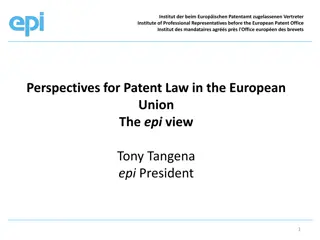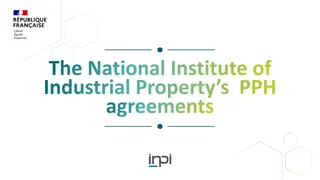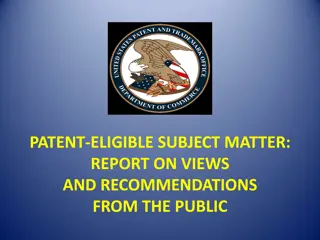USDA Office of Technology Transfer Patent Program Overview
USDA Office of Technology Transfer's Patent Program provides professional services for creating, managing, and convening Utility Patent Review Committees, preparing and prosecuting U.S. patent applications, advising on patent policies, and facilitating foreign filings. The process for protecting USDA ARS intellectual property for commercialization involves invention disclosure, committee review, approval, and patent filing. Scientists are encouraged to contact the Patent Advisor early in the invention disclosure process to preserve their rights.
Download Presentation

Please find below an Image/Link to download the presentation.
The content on the website is provided AS IS for your information and personal use only. It may not be sold, licensed, or shared on other websites without obtaining consent from the author.If you encounter any issues during the download, it is possible that the publisher has removed the file from their server.
You are allowed to download the files provided on this website for personal or commercial use, subject to the condition that they are used lawfully. All files are the property of their respective owners.
The content on the website is provided AS IS for your information and personal use only. It may not be sold, licensed, or shared on other websites without obtaining consent from the author.
E N D
Presentation Transcript
Intellectual Property and Technology Transfer: USDA Office of Technology Transfer Patent Program Patent Advisor Office of Technology Transfer 1
Service to ARS Scientists, Customers, Stakeholders Professional Services of ARS OTT Patent Section Create, manage & convene Utility Patent Review Committees (e.g., Invention Disclosure) Prepare, file, and prosecute U.S. patent applications, Coordinate cooperator-filed U.S. patent applications Facilitate and direct foreign filings with contractor Advise ARS scientist on ARS and USPTO Patent policy and procedures 2
Office of Technology Transfer Evelyn Rabin -- NAA 301 504-4781 Byron Stover ERRC 301-504-4783 Patent Advisors Byron Stover - BA 301-504-4783 Byron.Stover@ars.usda.gov Albert Tsui MWA & NPA 309-681-6512 Gail Poulos SAA 301-504-5302 Robert Jones-SAA 301-504-7270 Evelyn Rabin MSA 301 504-4781 David Marks 301-504-4619 Beth Sampson / Howard Owens PWA 510-559-6067 / 5731 Albert Tsui NPA 309-681-6512 3
Process for Protecting USDA ARS Intellectual Property for Commercialization Invention Disclosure Patent Advisor Committee Review Patent Advisor Approve, or Defer Prepare & File Patent Suspend
Submitting An Invention Disclosure Identification Of Potential Invention Scientist Initiates Scientist Advised To Contact PATENT ADVISOR ~~ EARLY~~ - Give the Patent Advisor a heads-up - BEST TIME: When preparing manuscript - Get advice on preserving rights
Submitting An Invention Disclosure ARIS NEW INVENTION DISCLOSURE-Highlights a. All information must be provided b. 115 release indicator check box c. Joint Inventor Entity Status d. Question 3 : can indicate if there is an affliated 115 e. Question 3: List and upload pdfs of publications f. Must print, sign and upload executed inventors page g. Other Docs page-add charts, tables, graphs pertaining to invention
National Patent Committees Three Subject Matter Committees Life Sciences Chemical Mechanical and Measurement Each cover all geographic Areas of ARS Each has at least 2 members on each Committee appointed by the Area. 7
National Patent Committees: Schedule Of Committees Meet quarterly Scheduled at the beginning of fiscal year
Committee Meeting Presentation Of Invention By In-Depth Reviewer Discussion By: Committee Members, Tech Transfer Coordinator, Deputy Assistant Administrator, Patent Advisor Licensing Staff Member, Marketing Staff Member NPLs Invited To Participate In Non-Voting Capacity Committee Members Vote, Recommend To: Approve Defer Suspend
Patent Committee Criteria Invention Disclosure Patent Advisor Committee Review Q1: Is there current commercial interest in the invention or a high probability of commercialization in the future? 10
Patent Committee Criteria Invention Disclosure Patent Advisor Committee Review Q2: Is the magnitude of the market relative to the cost of commercialization sufficiently large to warrant a patent? 11
Patent Committee Criteria Invention Disclosure Patent Advisor Committee Review Q3: Would the patent likely play a significant role in transferring the technology to the user? 12
Patent Committee Criteria Invention Disclosure Patent Advisor Committee Review Q4: Would a patent be enforceable, i.e., is the invention drawn to, or does it employ a unique and readily identifiable material or device which could be bought or sold? 13
Patent Committee Criteria Invention Disclosure Patent Advisor Committee Review Q5: Is the invention of sufficient scope to justify patenting? 14
Types Of Patent Protection UTILITY Patent Application - Enforceable for 20 years from the filing date -Deposits required PLANT Patent Application - Asexually Reproduced - No Deposit - Photographs - 1 Claim - Enforceable 20 Years From Filing Date Plant Variety Protection Certificate
Plant Variety Protection Certificate (PVPC) - Sexually Reproduced - Tuber Reproduced - Seed Deposit - Generally Enforceable 20 Years After Date Of Grant Of The PVPC
Patent Policies The research results are work products that belong to ARS, not the scientist ARS decides whether or not to apply for a patent, not the scientist (appealable) ARS decides whether or not to protect foreign patent rights, not the scientist (appealable) Such decisions require: No premature public disclosure Timely filing of an invention disclosure Timely and complete responses to requests from the Patent Advisor 17
PatentPolicies (con t) We do not patent tools We always allow license-free research We favor public releases over protection of plant IP: This is changing to a case-by-case review by the Plant Variety Committee
Due Diligence in Protecting Intellectual Property: Inventorship & Laboratory Notebooks Ownership of intellectual property is determined by inventorship An inventor must be able to document their contribution to conception & reduction to practice for at least a part of one claim in a patent application Documentation has strict legal requirements (a) Signed & witnessed lab notebook pages (b) Consecutive numbered bound pages, single line through errors (deletions) in data 19
IMPORTANT!! CRADAs and BRC PROJECTS REQUIRE SEPARATE ARS NOTEBOOK If you are conducting research under a CRADA or BRC project, all information and data must be recorded in a separate ARS notebook that is used only for that CRADA or BRC research. Version 10/01/2009
IMPORTANT!! CRADAs and BRC PROJECTS REQUIRE SEPARATE ARS NOTEBOOK If you are working on more than one CRADA or BRC project then you will have to use separate ARS notebooks for each project in addition to the ones you would use for non- CRADA , non-BRC research. Version 10/01/2009
America Invents Act First to Invent vs First to File a. One year grace period-not straight forward b. Prior art determined from Effective Filing date not Date of Invention c. Good Laboratory Practice-More Important than ever Filing as Inventor vs. Applicant a. USDA Office of General Counsel Requiring we file as applicant
Patent Time Line 2 Weeks 2-3 Months 1-2 year 2-3 Years 2-3 Months 3-5 Years Invention Disclosure Submitted Appeals Approval Issue Prosecution Application Preparation Committee
Patent Advisor Office of Technology Transfer 5601 Sunnyside Ave Beltsville, MD 20705 (301) 504-6905 http://www.ars.usda.gov/Business/ Business.htm IP management and R&D partnerships for our scientists, customers & stakeholders























